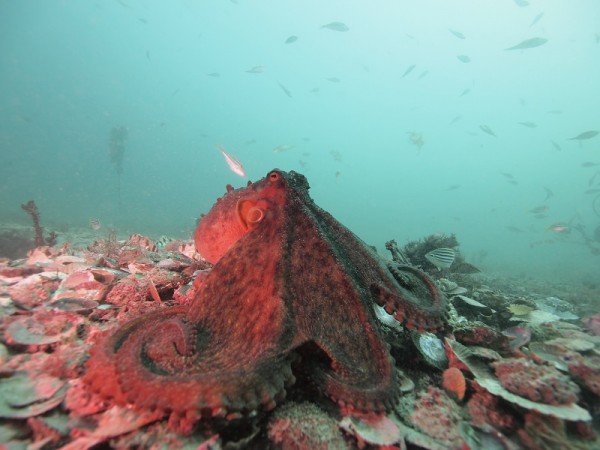By Ana Verayo, | January 30, 2016

Octopuses can show dark colors when aggressive and paler colors when non aggressive.
Scientists discovered that octopuses have more complex social interactions than first thought as biologists studied a group of octopuses off Sydneys' coast in Australia, where they observed new behavior indicating complex social skills.
Some of these social behavior included standing tall and turning dark where they spread their web of arms, which is most likely a sign of aggression. Alternately, during a losing fight, when an octopus turns pale in color, it means it is trying to avoid conflict or danger.
Like Us on Facebook
Prior studies say that octopuses prefer solitude, living in isolation where changing body colors are also strategies to ward off predators. However, according to co-author of the study, Peter Godfrey-Smith of The City University of New York, their new findings reveal a new perspective on changing octopus behavior as the team studied 53 hours of octopus footage.
Godfrey-Smith says that the octopus can turn very dark and stand erect in such a way that it emphasizes its size or will stand at higher ground when they become aggressive. This behavior involves trying to make it appear as big and domineering at it can possibly be, where the arms are also raised over its head which is called the "Nosferatu" pose.
Apparently, there is no specific physiological reason why this dark coloration is associated with aggression however, this does give the optical illusion of a larger object.
On the other hand, when octopus retreat from an oppressor, they turn pale and also reveal high contrast patterns that are called deimatic displays. These are contrasting patterns that are often observed when octopuses want to hide in their den or when they are forced out by an aggressor, or when an aggressive octopus is in the area.
Godfrey-Smith says that this pale color is often interpreted as non confrontational behavior. However, when two octopuses display dark colors, they are most likely to fight within close proximity of each other. However, when a pale colored octopus retreats, the darker colored one will most likely stand its ground.
Apart from the octopus, another cephalopod can also change its coloration during a fight, where the cuttlefish also shows similar features. Aggressive cuttlefish males can darken their faces where paler, non aggressive males retreat from fights.
This new study is published in the journal Current Biology.
-
Use of Coronavirus Pandemic Drones Raises Privacy Concerns: Drones Spread Fear, Local Officials Say

-
Coronavirus Hampers The Delivery Of Lockheed Martin F-35 Stealth Fighters For 2020

-
Instagram Speeds Up Plans to Add Account Memorialization Feature Due to COVID-19 Deaths

-
NASA: Perseverance Plans to Bring 'Mars Rock' to Earth in 2031

-
600 Dead And 3,000 In The Hospital as Iranians Believed Drinking High-Concentrations of Alcohol Can Cure The Coronavirus

-
600 Dead And 3,000 In The Hospital as Iranians Believed Drinking High-Concentrations of Alcohol Can Cure The Coronavirus

-
COVID-19: Doctors, Nurses Use Virtual Reality to Learn New Skills in Treating Coronavirus Patients







